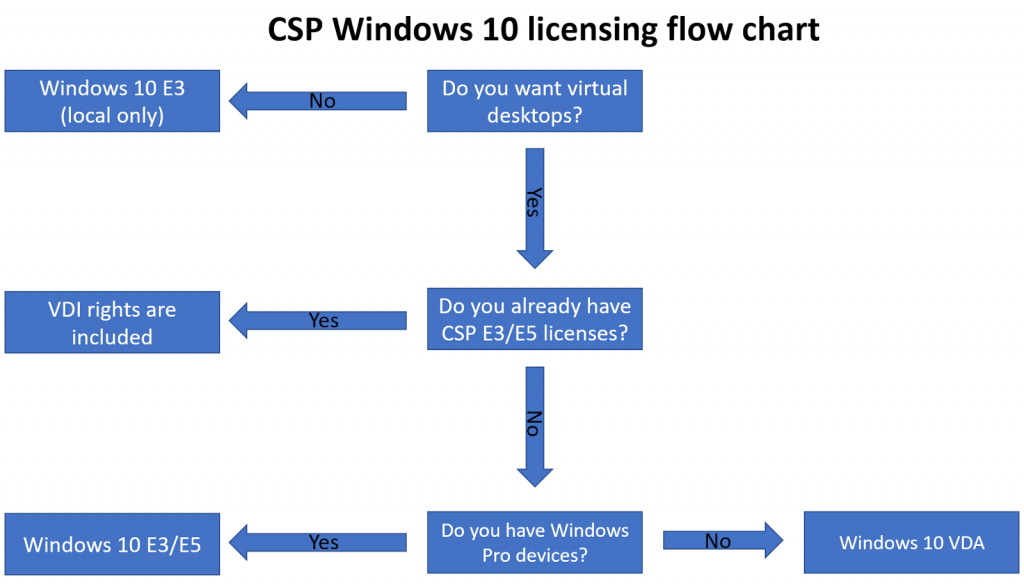Windows 10 gets Virtualisation rights on CSP
Although it wasn’t mentioned in the Day 1 keynote at Microsoft Inspire, a pretty interesting announcement was made via the Windows Blog:
Microsoft are adding virtualisation rights to Windows 10 purchased via the CSP program

Hang on, what’s CSP?
The Cloud Solution Provider (CSP) program is aimed at managed services partners, to give them more flexibility to deploy Microsoft cloud services as part of their solutions. Microsoft say it enables partners to
“go beyond reselling licenses to being more involved in (a) customer’s business”
Despite its cloud moniker, it also includes Windows 10 and the lack of VDI (Virtual Desktop Infrastructure) rights has been one of the biggest differences between CSP and traditional volume licensing programs such as Open and EA.
So, what’s the big deal?
While the majority of end customers may not have been clamouring for these virtualisation rights, there has been a vocal set of partners very keen to see this change occur. This, coupled with another rule change from Microsoft, makes true Cloud Hosted Virtual Desktops a reality.
Previously, Microsoft have never allowed virtual images of a Windows desktop to be delivered from a shared cloud environment. While hosted desktops have been available, from Amazon for example, these have actually been Windows Server “skinned” to look like the desktop OS.
Back in October 2015, Microsoft announced that they would allow Windows 10 VMs to be run in Azure, when licensed under the per-user model in Volume Licensing, using Citrix XenDesktop Essentials. Now Microsoft have made it possible via CSP licensing too.
What’s available?
From September 6, the SKU line-up for Windows 10 in CSP will look like this:
- Windows 10 Enterprise E3 (Local Only)
- Windows 10 Enterprise E3
- Windows 10 Enterprise E5
- Windows 10 Enterprise E3 VDA
- Microsoft 365 Enterprise E3
- Microsoft 365 Enterprise E5
Organisations who have no interest in virtual desktops can purchase the “local only” SKU, which is at a lower price than those with the new rights.
Organisations already licensed with E3 or E5 will be granted the new virtualisation rights with no price increase.
Organisations who want to access hosted Windows desktops – but don’t have Windows devices – will be able to use the new VDA (Virtual Desktop Access) license.

It’s important to note that the CSP licenses, even with their new rights, do NOT allow on-premises VDI use…only in the Cloud. Volume Licensing such as Open, MPSA and EA is still the only option for on-premises VDI deployments.
Is it only Azure?
No.
Microsoft have opened this up to 3rd party hosting partners too. However, it’s not available to just any hosting partner – they need to be a:
Qualified Multi-Tenant Hoster
A Qualified Multi-Tenant Hoster, or QMTH for short, needs to be both a:
Direct CSP partner + SPLA partner
These partners will also be qualified to host desktops for organisations with Windows 10 Enterprise Per User licenses via Volume Licensing channels.
The QMTH program goes live August 1, 2017. The list of authorized partners is currently blank (here) but this should be updated in a few weeks.
Conclusion
The ability to host true Windows desktops in the Cloud has been a long standing item on the wishlist of many partners for years. Now, with the increasing trend of Software As A Service (SAAS) and Bring Your Own Device (BYOD), coupled with the rise in people able to “work from anywhere” – perhaps this is the right time for Microsoft to finally break down these barriers and allow Cloud VDI.
It certainly seems that it will open up a whole new area for the partner eco-system to grow and develop and, if you’re considering deploying VDI but don’t want to manage and maintain the server infrastructure, a partner managed offering could be just the ticket. However, I’m interested to understand more about the customer demand.
Do you feel this is something that would work well within your business?
Would cloud hosted Windows desktops solve a pain point for you and/or address a business need?
If you’ve got questions, thoughts etc. – let me know in the comments below, on Twitter, on LinkedIn or via email – rich.gibbons@itassetmanagement.net.
Related articles:
New UK Microsoft Licensing Training Course
Podcast: Managing Microsoft in the Datacentre
Microsoft True-down, Software Assurance, and Citrix are key issues according to CCL research
Podcast Episode 67: “Asset Managers can bring unique value to the cloud”, Patricia Adams - Flexera
Microsoft Azure Hybrid Benefit for SQL Server
VMWare running on Azure
- Tags: CSP · Microsoft Inspire · Virtulisation · Windows 10
About Rich Gibbons
A Northerner renowned for his shirts, Rich is a big Hip-Hop head, and loves travel, football in general (specifically MUFC), baseball, Marvel, and reading as many books as possible. Finding ways to combine all of these with ITAM & software licensing is always fun!
Connect with Rich on Twitter or LinkedIn.

Thank you Rich for this very informative post. May I ask what is your reference that the Windows 10 Enterprise E3 VDA cannot be used in Onpremise VDI? Please.